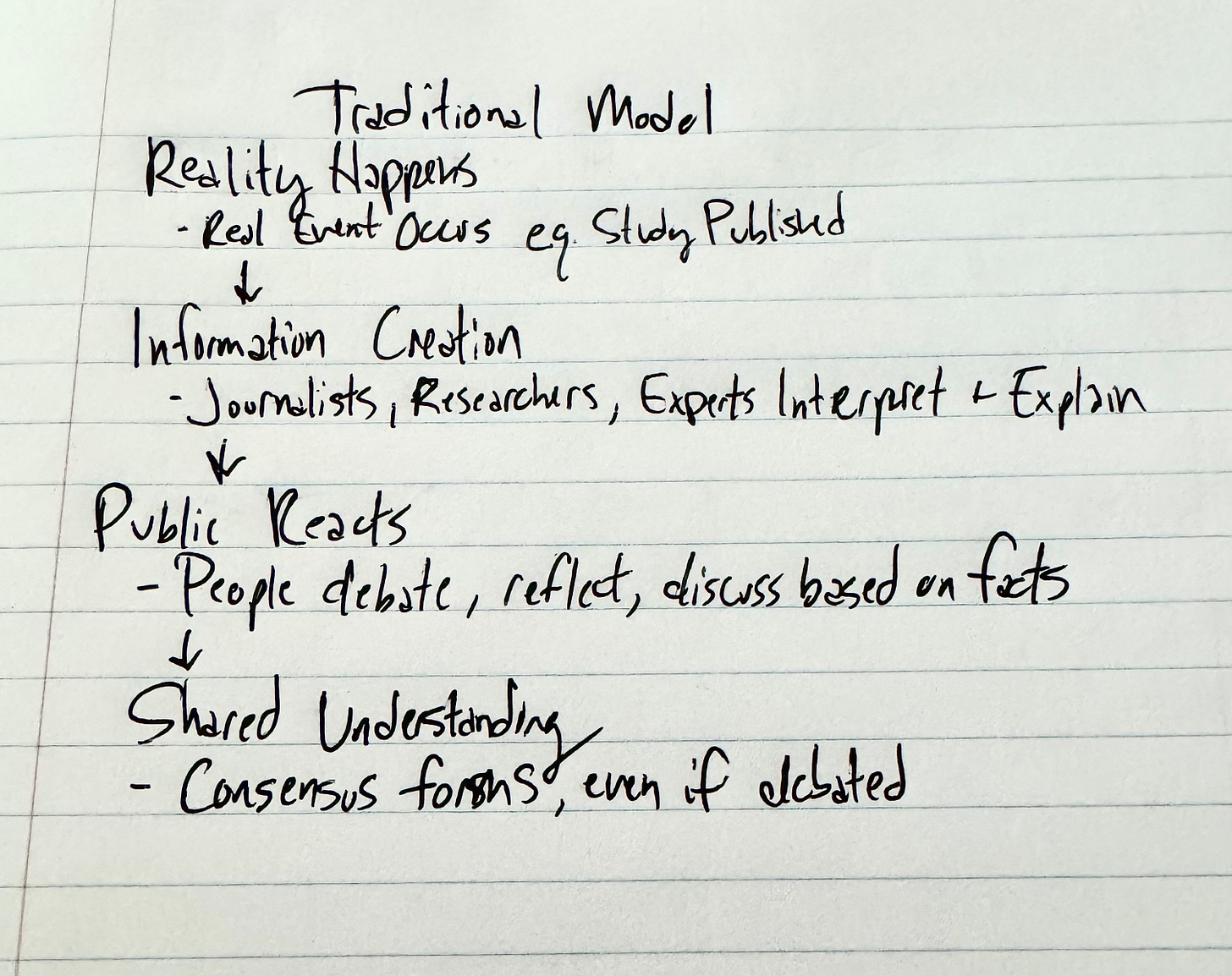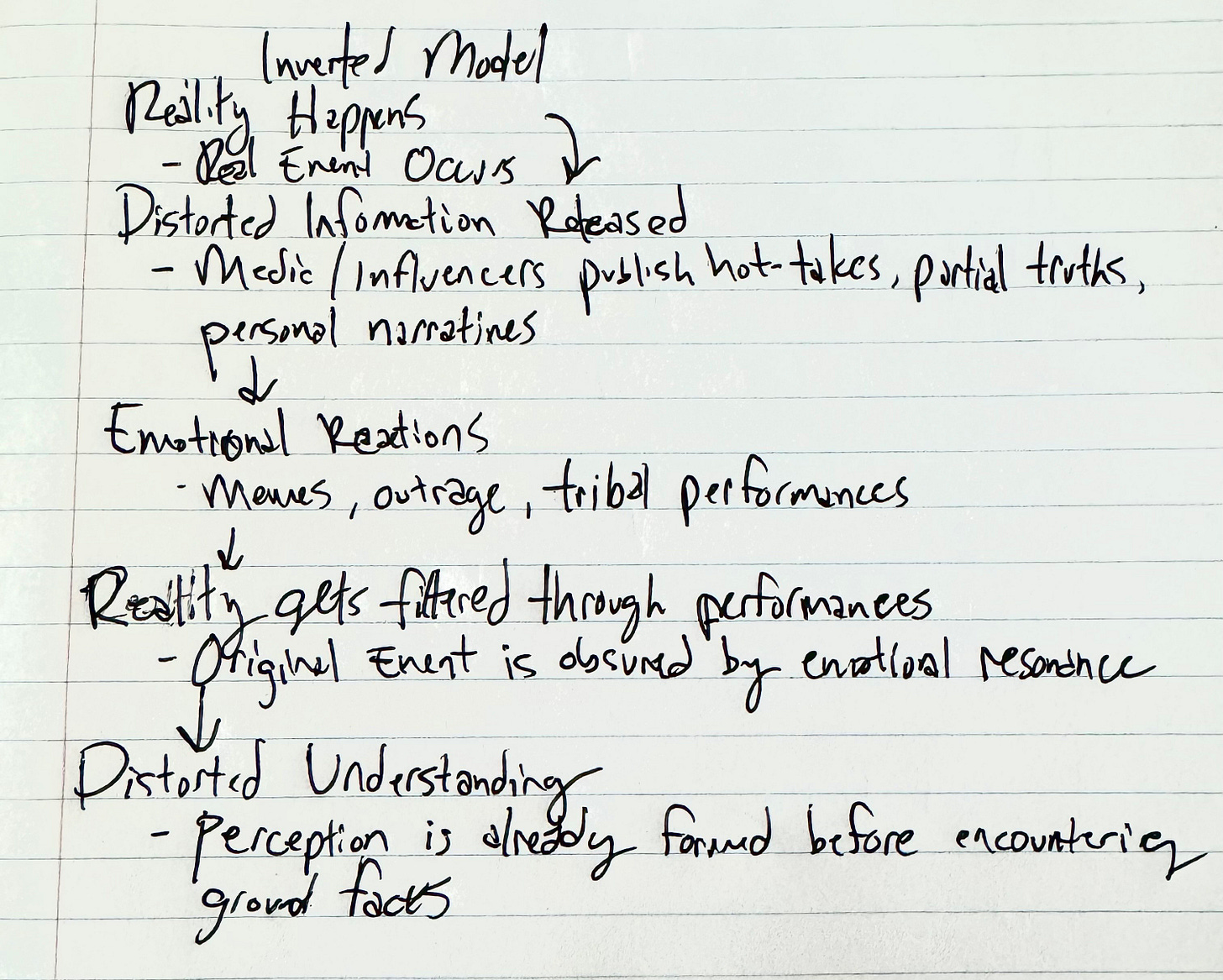Reality-Reaction Inversion: Why Feeling Beats Fact in the New Town Square
Before we know what happened, we know how to feel about it.
**This is Part 1 of a new introductory series exploring how reaction, performance, and emotion are reshaping truth itself. Today’s piece begins with the core phenomenon: how reactions now precede events—and why that reversal is at the root of our emerging post-truth culture.**
According to researchers at MIT, falsehoods spread 70% faster than truths online and reach six times as many people. Humans haven't suddenly lost their ability to discern fact from fiction; the speed and volume of information have fundamentally changed our relationship with truth.
We've all experienced it: viral posts denounce scientific studies no one has actually read. Random accounts with 67 followers passionately critique thousand-page bills they clearly haven't read themselves. As AI becomes more ubiquitous, we may reach a point where even "authors" of such documents merely review AI-generated summaries rather than engaging with complete texts.
By the time you learn the actual facts, your perception of the issue has been shaped by a barrage of reactions. This creates an inversion of normal cause and effect, where reactions come before events, commentary comes before facts, and performance, the signaling of emotion and allegiance, replaces engagement with substance. Our first impressions are shaped not by the facts, but by how the facts are performed for us. By the time you encounter the reality underneath, you've already absorbed dozens of emotional cues telling you how to feel and interpret the event.
In the traditional flow of knowledge, events generated information, which trusted sources dispersed through established channels, allowing the public to react after absorbing facts. Today, this sequence has fundamentally reversed: reactions erupt before facts are understood, emotional anchors form first, and information arriving later gets filtered through these pre-existing narratives.
This reversal has at least one side effect, what might be called an "epistemic sunk cost fallacy." Once emotionally invested in a position, abandoning it may feel like a loss. Instead of updating our beliefs based on evidence, we filter incoming information to validate positions we've already claimed, bending facts to fit our emotional commitments rather than adjusting our views to accommodate new data.
“We are terrible at criticizing our own belief structures because we don't reason to find truth — we reason to defend what we already emotionally believe.”
—Jonathan Haidt, The Righteous Mind
Information Overload and the Barriers to Understanding
Today's information ecosystem presents a paradox: we have unprecedented access to information yet struggle to process it meaningfully. Legislation bills stretch thousands of pages while scientific journals hide behind expensive paywalls. We're left piecing together fragments from social media, like assembling a puzzle without seeing the complete picture.
This information density marks a stark departure from previous eras. Historical legislation was designed to be read and understood:
Social Security Act of 1935: Around 64 pages. Established the entire Social Security system: retirement, unemployment insurance, and welfare.
Homestead Act of 1862: About 6 pages. Gave settlers free land to encourage Western migration—one of the most consequential land policies in American history.
Civil Rights Act of 1964: About 24,000 words (60-70 pages). Ended segregation in public places and banned employment discrimination.
G.I. Bill (1944): Roughly 20 pages. Created education and housing benefits for returning WWII veterans that reshaped American society.
Contrast these with contemporary legislation:
Affordable Care Act (2010): About 2,700 pages. Made significant healthcare changes but became symbolic of unreadable legislation ("We have to pass the bill to find out what's in it"—Nancy Pelosi).
Dodd-Frank Wall Street Reform Act (2010): Over 2,300 pages. Created massive bureaucratic complexity with thousands of pages of follow-on regulations.
CARES Act (2020): 880 pages plus hundreds more in guidance. Passed quickly for pandemic relief but packed with hidden provisions and special interest carveouts.
Annual Omnibus Spending Bills: Typically 2,000+ pages. Combine funding for hundreds of agencies into unreadable documents passed hours before deadlines.
Inflation Reduction Act (2022): About 730 pages. Title masked its actual contents spanning green energy credits, healthcare subsidies, and tax restructuring.
This proliferation of complexity reflects our broader information crisis. When documents become unreadable, public understanding depends on secondhand interpretations. The gap between what institutions produce and what citizens can realistically process widens, accelerating the inversion of understanding. Without direct access to original information, we increasingly rely on reactive interpretations, further distancing ourselves from source material.
The Ephemeral Nature of Modern Discourse
Martin Luther nailed his 95 Theses to a door, kickstarting the Protestant Reformation. This was a slow, physical, high-effort act. The document stayed up. People gathered, read, and discussed. It couldn't vanish into a feed. Today, the equivalent would be a viral thread forgotten in less than 48 hours. What once played out in town halls now unfolds through algorithms optimized for engagement over accuracy. Though, we are trying to keep up. Even the metaphor of public discourse was co-opted by Elon Musk, who justified his Twitter acquisition by calling it the world's "town square." We have immediacy but no staying power. The ephemerality of our information age prevents thoughtful digestion and deliberate processing. Our System 1 thinking has been hijacked.
“System 1 operates automatically and quickly, with little or no effort and no sense of voluntary control.”
—Daniel Kahneman, Thinking, Fast and Slow
This acceleration of information flow contributes directly to the perception-formation process. When content disappears from view so quickly, we're left with impressions rather than understanding. The physical permanence of Luther's theses allowed for extended consideration and meaningful debate. Contemporary digital discourse, by contrast, rushes past before we can fully comprehend it, leaving behind only our emotional responses. This is precisely how reactions come to precede understanding, we simply don't have time to understand before we must react.
The Acceleration of Emotional Certainty
This is the reality-reaction inversion at work: emotional certainty hardens before the facts even have a chance to disperse and stabilize. In today's information ecosystem, feelings aren't reactions to knowledge, they are the foundation onto which knowledge must retrofit itself. Consider how quickly narratives crystallized when COVID-19 first emerged. Scientific understanding evolved daily, but public perception fractured into hardened positions within weeks. Before experts could establish consensus on masks or vaccines, millions had committed to immovable stances based not on whose evidence was strongest, but whose voice of certainty resonated with their existing beliefs regardless of whether the source was an expert, conspiracy theorist, or internet troll. Scientific knowledge's gradual, cautious progress couldn't compete with confident declarations flooding social feeds.
The ground reality is submerged under layers of reaction, each reinforcing not understanding but the illusion of certainty. Social media algorithms understand this reality better than we do. They measure precisely what content keeps you engaged—not what informs you or challenges you, but what makes you feel something strongly enough to keep scrolling. This creates self-reinforcing cycles where emotional resonance becomes the organizing principle of information, replacing accuracy, context, or usefulness.
Real-World Consequences
The ramifications of this inverted information process extend far beyond academic concerns, they reshape our daily lives in tangible ways.
In healthcare, patients form strong opinions about treatments before consulting medical professionals. Online testimonials circulate while complex medical literature remains inaccessible. When a celebrity endorses the hottest new health fad, millions commit emotionally before any evidence can be properly assessed. The result? People refuse effective treatments while embracing ineffective or harmful alternatives.
Financial decisions follow similar patterns. Investment bubbles form through emotional momentum rather than careful analysis. Crypto currencies and speculative assets rocket in value based on sentiment, not fundamentals. By the time cautionary analyses emerge, many have already suffered losses from decisions made when hype preceded understanding.
This isn't merely a shift in information consumption, it's a fundamental reordering of decision-making across every domain of life. We no longer live through events themselves. Instead, we experience layered interpretations that shape our perception before we've formed our own understanding.
Welcome to Post-Truth Culture
Martin Gurri spent years as a media analyst for the CIA, studying how information flows shape politics. In his book The Revolt of the Public, he frames our predicament not as mere information overload but as a fundamental crisis of authority. What we're witnessing isn't just an erosion of information quality but the emergence of a post-truth culture, where objective facts become less influential in shaping public opinion than appeals to emotion, identity, and tribal belonging.
Oxford Dictionaries recognized this shift by naming "post-truth" its 2016 word of the year, acknowledging a reality where what matters isn't verification but visceral resonance. In a post-truth environment, information rises based on emotional impact, not rigor. Debate becomes less about uncovering shared reality and more about projecting certainty, outrage, or emotional gravity.
"The public today is not a deliberative body, it is a loose collection of angry individuals searching for confirmation, not truth."
—Martin Gurri, The Revolt of the Public
Gurri argues that digital networks have fundamentally altered the relationship between authority and the public, creating "a world where assertions can fly without the traditional constraints of authority, expertise, or even logic," leading to a fragmentation where no institution can claim final interpretative power.
Post-truth emerges when reality-reaction inversion becomes the dominant operating system, when reactions consistently precede facts, emotional alignment outcompetes evidence, and signal strength becomes a proxy for truth. We no longer merely misinterpret reality; we replace it with competing performances of certainty, leaving no common ground, only overlapping tribal narratives performing conviction for their respective audiences.
When algorithms are designed to exploit our emotional responses rather than expand our understanding, whose responsibility is it to redesign our digital "town square", and what would that redesign prioritize?





